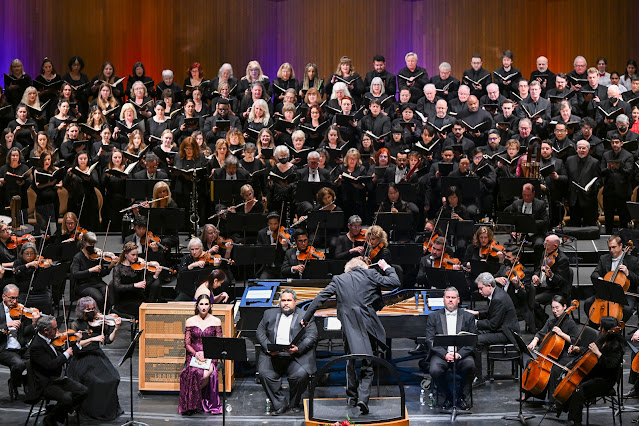REVIEW
Long Beach Symphony at the Terrace Theater, Beverly O'Neill Performing Arts Center, Long Beach
DAVID J BROWN
Long Beach Symphony Orchestra, vocal soloists Anna Schubert (soprano), Ashley Faatoalia (tenor) and James Martin Schaefer (baritone), the Long Beach Camerata Singers and South Bay Children’s Choir, and the Silver-Garburg Piano Duo, all under the baton of the LBSO's Music Director, Eckart Preu.
Given that Carmina Burana's length of just on an hour is slightly awkward for concert programming—like Beethoven’s Ninth and some Bruckner and Mahler symphonies, it’s too short to stand by itself but too long for any other extended work to be included—Maestro Preu’s selection for the first half was Ángeles de Llama y Hielo (Angels of Fire and Ice), written in 1993-94 by the Mexican composer Ana Lara (b. 1959).
 |
| Ana Lara. |
Preu’s handling of the score had as much focus and sense of direction as the piece allows, and the LBSO responded with its customary skill, care and commitment—the antiphonal placing of two percussion groups, and the harps far left and far right at the front of the platform, were particularly pleasing effects. But to my ears, each movement had a too-similar effect and with diminishing returns: impressively portentous scene-settings but which led nowhere, and with insufficient differentiation to match the given subjects.
After the interval, the ultra-familiar galvanic roar of O Fortuna was welcome. However, there are some thickets to be navigated before one can get to grips with Carmina Burana as a piece of music per se. First there’s the ubiquity of O Fortuna itself and the near-impossibility of dissociating it from the innumerable ad and movie sound-tracks that it’s adorned, as well as its begetting of endless near-clones whenever a film composer, hard-up for originality, wants to underscore scenes of epic barbarism on the screen.
 |
| Orff at around the time he composed Carmina Burana. |
What Orff does supremely well—while sidestepping historically informed “authenticity”—is to clothe the 13th century poems that are his subject in exactly appropriate music: as vivid, direct, and down-to-earth as the verses themselves, pungently scored for forces in which multiple percussion and the two pianos (the Silver-Garburg Duo bitingly prominent when required) often take the rhythmic lead. This fitness for purpose of the music was admirably clarified by the texts being projected as supertitles, a far more satisfactory solution than extensive printing in the program book would have been.
 |
| Dr. James Bass. |
The choir appears in all but five of the 25 numbers that are spread across the work’s three large sections, singing in a wide and demanding variety of styles: rapid and strongly accented polysyllabic chanting, recitatives that turn on a dime between pp and ff, unaccompanied unison quasi-plainchant, as well as many full-throated outbursts. Throughout, the Long Beach Camerata Singers covered themselves with glory, as did the South Bay Children’s Choir when their big solo moment arrived at the start of Part III, Cour d’amours (Court of love).
 |
| James Martin Schaefer. |
Part I, Primo vere (In spring), is the longest of the three, and as always, I felt some longueurs: surely there are a couple too many alternations between cheery German choruses and chunky orchestral dances, for all the energy and rhythmic élan that the Camerata Singers and LBSO brought to them? For me, the advent of the brief Part II, In Taberna (In the tavern), brings the work onto much more satisfying expressive ground, where it remains until the end.
 |
| Ashley Faatoalia. |
 |
| Anna Schubert. |
 |
| Eckart Preu. |
Heretically, I’ve always wished that Carmina Burana ended at this chorus, with of course a suitable harmonic resolution added, rather than leading directly as it does into the reprise of O Fortuna—but which of course makes appropriate dramatic sense, closing the circle of the inexorable wheel of fate, and on this occasion bringing the near-capacity audience in the Terrace Theater instantly to its feet, cheering. Truly this evening was a memorable success for the LBSO.
---ooo---
Long Beach Symphony Orchestra, Terrace Theater, Beverly O'Neill Performing Arts Center, Long Beach, Saturday, March 11, 2023, 8 p.m.
Images: The performers, Eckart Preu: Caught in the Moment Photography; Final applause: Todd Mason; "Wheel of Fortune" and Ana Lara: Wikimedia Commons; Orff: Carl Orff Foundation website; James Bass: Long Beach Camerata Singers website; Anna Schubert: J.D. Renes/artist website; James Martin Schaefer: artist website; Ashley Faatoaila: artist website.
If you found this review to be useful, interesting, or informative, please feel free to Buy Me A Coffee!

















No comments:
Post a Comment